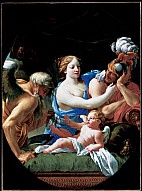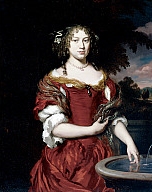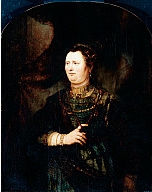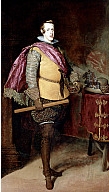| PEARLS AND OTHER WONDERFUL THINGS by
Goody Hirshfeld
Docent to Docent presentation 2007
If you take a leisurely walk through the galleries, you will notice that many painting
are replete with jewels of all descriptions. But, the one thing that piqued my attention
was the number of paintings that featured pearls, particularly in the Renaissance and
Baroque galleries. Actually, the word “baroque” originally referred to pearls
that were irregularly formed, full of bumps and globules. When an exuberant new style of
architecture became popular in the 17th century Europe, its critics mockingly nicknamed
the style “baroque” suggesting that these structures were grotesque, like ugly
pearls. But the word caught on, and even came to have a positive meaning.
Throughout most of recorded history, pearls were considered incomparable treasures. In
the New Testament, there are numerous references to the esteem in which pearls were held.
Christ repeatedly referred to them as something most precious. The Talmud also referred to
pearls as signifying something beautiful or very costly. Before the creation of cultured
pearls in the 1900s, natural pearls were so rare and expensive that they were reserved
almost exclusively for the noble and the very rich.
The ancient Romans valued pearls highly, especially as a symbol of wealth and prestige.
The Emperor, Julius Caesar, had already drawn up his own strict law in Rome that only
aristocrats might wear pearls. In 55 B.C., Julius Caesar stood on the coast of France
watching his ships preparing for an invasion of England. According to his gossipy and only
marginally reliable biographer, Gaius Suetonius Tranquillus, it was not only
Britain’s mineral wealth that persuaded Caesar to make his military move across the
Channel. It was for his lust for Britain’s pearls which were much desired in the
ancient world! Caesar wanted to make sure his personal supply of pearls were guaranteed,
not only to satiate his own passion for pearls but also to gift his many mistresses.(Just
one perfect pearl could assure one of his paramours a comfortable retirement. There is no
doubt that it was pearls that were a Roman girl’s best friend). Heads of state do go
to war for the strangest reasons! In any case, Caesar failed to conquer Britain and so had
to get his pearls elsewhere.
Shortly after Caesar died, near the end of the 1st c. B.C., Cleopatra and her new
lover, Marc Anthony, made an outrageous bet. Which of the two lovers, the mighty Roman
general or the haughty Queen of Egypt, would offer each other the most expensive feast?
According to Pliny in his treatise, “Natural History”, Cleopatra owned two
pearls that were the largest in the whole of history.
 |
|
She appeared at the banquet dressed in all her finery with
the fabulous gems in her ears. The table was set with elaborate dinner plates. According
to previous instruction, the servants placed in front of her only a single vessel
containing strong, rich vinegar capable of melting pearls. She took one earring off and
dropped the pearl in the vinegar, and when it was melted, swallowed it. Astounded, Anthony
declined his dinner….the matching pearl….and admitted she had won. In our
painting, Anthony holds a large wine glass and seems to be fending off Cleopatra and the
pearl which she holds between her finger and thumb. Actually, this story was told by a
despairing Pliny to point out the decadence and excesses of the Roman Empire. Both
Anthony, wearing the laurel leaves of victory, and the crowned and bejeweled Cleopatra
seem to be more than a bit tipsy. The painting by the French artist, Claude Vignon, is
both fantastic and funny. |
Early on, pearls acquired multiple symbolic meanings, standing for worldly vanity
as well as faith. While white pearls became a symbol of Mary’s purity, a quality
transferred to those women wearing them, they also came to be associated with the love
goddess, Venus.
Vignon was acquainted with the artist, Simon Vouet who painted “Time Discovering the
Love of Venus and Mars.” Venus was an enigmatic goddess, representing at different
times earthly love as well as divine love. Even the story of her birth is told in many
versions. Some myths state that she was born of Jupiter and a nymph. However, the poet
Hesiod provides a much more elaborate and entertaining explanation for her birth. His myth
states that the Titan Cronus castrated his father Uranus and then cast the severed
genitals into the sea. From the foam that gathered around the severed sex organs, Venus
emerged from the sea, fully formed and ready to go.
 |
|
So, very early on, her persona was tainted with eroticism. Some say that she was then
wafted ashore atop a sea shell. . Think of Botticelli’s “The Birth of
Venus” (familiarly called Venus on the Half- Shell). It was said that the ancients
all agreed to dedicate the pearl to Venus. After all, it was she who was the deity born
from the sea. There exists an entire web of associations between Venus and pearls (which
we see adorning her hair). Venus’ high profile affair with Mars, the God of War is
the subject of this painting. Incidentally, Venus who was one of the 12 great Olympians,
was the only goddess with an active sex life. Venus was married to the lame and
unattractive, Vulcan. That did not stop her from carrying on a series of torrid love
affairs. In revenge, Vulcan, the blacksmith, traps Venus, Mars and their love child,
Cupid, on his marriage bed, enveloping them in an invisible net. He then invites the other
gods to mock them. Vignon has taken some artistic liberties with the story. He has
substituted Cronus (Time/Death) for Vulcan. Vulcan can be seen on the left casting his net
over Cupid, perhaps suggesting that even love and beauty can be vanquished by time. |
In the 17th c. the Dutch led the world in commerce. The Dutch burghers were
experiencing a surge in economic prosperity that created an unprecedented boom in artistic
creation. While elsewhere in Europe power was held by kings or popes, the Netherlands was
creating a civil society run by the bourgeoisie. Portrait painting reached great heights
of popularity at this time. As you enter this gallery, you cannot help but notice the
proliferation of pearls in ears, woven in hair and gracing the bosom and the wrist. From
housemaids to wealthy dowagers, pearls were in style!
 |
|
The newly betrothed woman in this pendant portrait wears a large pearl drop in her
ears and in her headdress. She is dressed as the goddess Venus which is definitely more
fun than wearing the sober clothes of the Calvinist Dutch and gives her the opportunity to
show off some skin. Her very ordinary mate-to-be is holding the spear of Adonis. These
portraits were painted as pairs and were to be hung together for an eternity.
Unfortunately, in this case, the two were separated, and John Ringling purchased the woman
alone. In later years, an anonymous donor discovered her intended, and they are reunited
here, side by side. While Venus had many lovers, the myths lead us to believe that none
was dearer to her than a handsome young shepherd named Adonis. When she spied the
beautiful, young Adonis he became her first, but not last, mortal lover. His death in
combat with a wild boar brought her terrible grief. In the Vouet painting Venus is an
experienced woman of the world. Here, she takes on another guise as the symbol of married
love, fidelity and innocence. Through the ages pearls have been held in high esteem for
both their unrivaled beauty and association with both love and marriage. A word about the
rose. It was deemed sacred to Venus in antiquity and is often pictured as one of her
attributes, largely because of its beauty and fragrance. It was common to compare the
pricking of its thorns to the wounds of love. |
In the story of Venus and Adonis, it was originally a white flower, but while
Venus was hastening to assist the dying Adonis, a thorn pierced her foot and the drops of
blood fell on the white petals staining them red. Times may change, but the symbols have
not. At my daughter’s wedding she wore a strand of pearls and carried a bouquet of
red roses.
 |
|
 |
|
In at least 20 portraits, Nicolaes Maes painted a woman, elegantly dressed, dipping
her hand in a fountain. In the 1660’s when the Portrait of Anna Hofstreek was
painted, many rich Dutch burghers were emulating the lifestyles of the nobility. In this
case, the garden setting with a fountain supports the impression of wealth. Notice
Anna’s elaborate dress, especially the elaborate display of pearls in her hair,
around her neck, and her bodice. Again, we face a myriad of symbols. Water has long
symbolized purity, as do pearls. They are both “cool” in nature and are both
symbolic of femininity. By picturing Anna Hofstreek dipping her hand in the
fountain’s clear water, Maes alludes to her chastity…..a highly lauded virtue to
a young unmarried 17th century woman. |
Before we leave this gallery, we must look at the wonderful, “ Portrait of a
Woman”, from the studio of Rembrandt. A fleshy, intense, bejeweled women peers at us
from the darkness that envelops her. She might be the heroine in an early 16th c. play
about the history of Amsterdam. Her jewelry is stunning, but is it real? Could it be part
of the acting company’s store of theatrical accessories? She has a large black pearl
in her ear. Black pearls were symbols of wealth, were very highly prized and unbelievably
expensive. There is a good chance that they are fakes. During the 17th c. a Parisian
artisan patented a method of making fake pearls. Hollow blown glass balls were coated with
varnish mixed with iridescent ground fish scales. This discovery made Paris the main
producer and disseminator of faux pearls for well over 200 years. Even for ladies of
means, it was quite acceptable to wear faux pearls during the day and save the real thing
for an evening event.
 |
|
Our last pearl of the day graces a handsome, broad-brimmed hat turned up on one side
and trimmed with a luxurious plume held by a large pearl. (Nothing faux here.) The hat
belongs to King Philip the IV of Spain, an unpopular monarch who accelerated Spain’s
demise as a world power with his wild spending habits. The expensive and ongoing struggles
between Spain and the Netherlands had weakened the economy. A sizeable portion of the
wealth that came from Spain’s colonies in the Americas was hoarded by the monarchy in
the form of jewelry and liturgical objects. Philip the IV’s taste for luxurious
objects is well illustrated in the following story….. Knowing the King’s
penchant for beautiful pearls, his dealer in rare jewels invested his entire fortune on
the purchase of one perfect pearl. “How have you ventured to put all your fortune
into such a small object asked His Royal Highness? Because I knew there was a king of
Spain to buy it from me” was the quick reply. And Philip rewarded the faith of his
jeweler by purchasing the pearl. There is no record of this particular transaction, but we
know that his grandfather, Philip II, was equally aggressive in search of the rare and
beautiful. |
Let me tell you a tale that links the Spanish monarchy to Hollywood. It is said
that one of the most famous and coveted pearls in the world, La Peregrina ( the wanderer)
was found by a slave diving for pearls in Panama. He gave it up in return for his freedom.
In 1570 the conquistadors sent the pearl to King Philip II of Spain. King Philip then
gifted it to his betrothed, Mary I of England (Mary Tudor a.k.a. Bloody Mary). After her
death, it reverted back to the coffers of the Spanish royal treasury, and was evidently
worn by Queen Margarita, the wife of Phillip III and the mother of Philip IV, and Isabel
of Bourbon, the first wife of Philip IV (our Philip). Velasquez painted both these ladies
wearing the coveted jewel. Their portraits hang in the Prado. Margarita is depicted
wearing La Peregrina as a brooch fastened to her bodice; Isabel wears the jewel suspended
on a long chain. Isn’t it possible that after the ladies demise, our Philip borrowed
it and used it to adorn his hat? As time passed, it was acquired by the Bonapartes of
France, who sold it to a British Marquis. After disappearing for a century, the pearl
turned up once again in 1969 at a New York auction house. It was purchased by ( can you
guess?) Richard Burton who gave it to Elizabeth Taylor. It is pear shaped and measures
about 1 1/2 inches long. Ms. Taylor had Cartier reset it with diamonds, pearls and rubies.
A case of Hollywood royalty and Spanish royalty sharing the same object!
ringlingdocents.org
|





